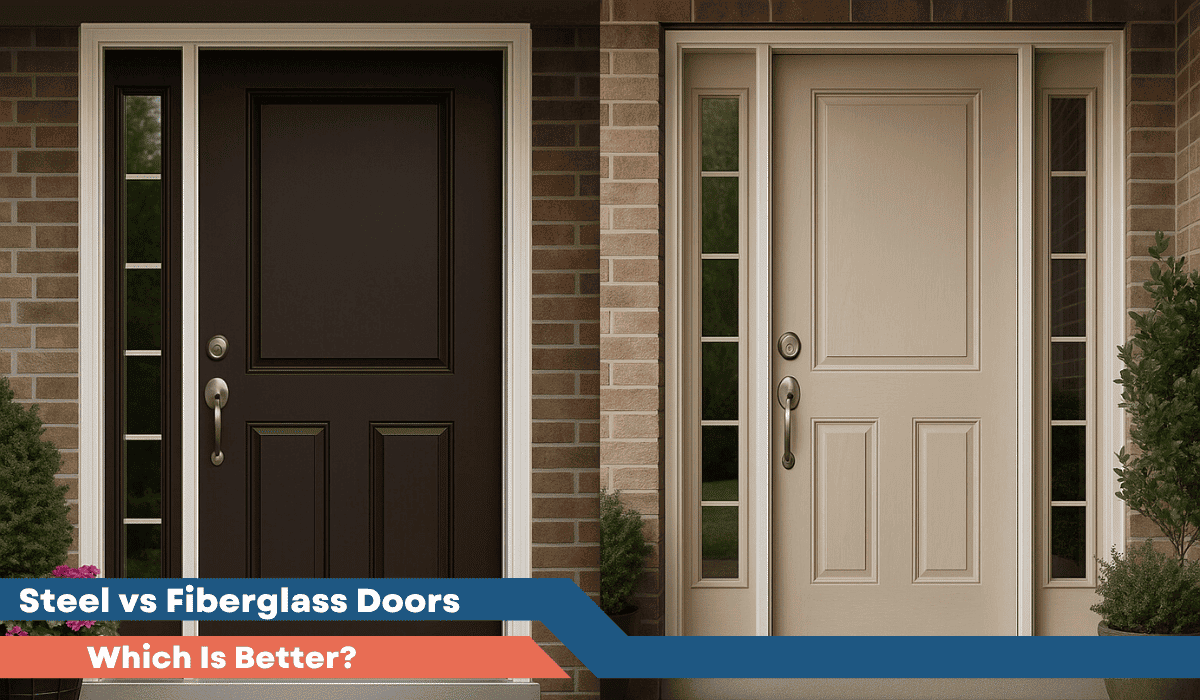Choosing a new front door isn’t just about looks. It affects your home’s security, energy bills, and how it holds up through seasons.
And with steel and fiberglass leading the pack, it’s easy to get stuck weighing pros and cons.
If you’re not sure which is right for your space, we’ll break down how each performs when it really counts.
Key Notes
- Steel doors offer superior security and lower upfront costs than fiberglass.
- Fiberglass excels in energy efficiency, weather resistance, and aesthetic flexibility.
- Climate impacts differ: steel rusts in humidity, fiberglass handles all weather.
- Maintenance requirements favor fiberglass with minimal upkeep versus steel’s regular care.
Quick Comparison: Steel vs Fiberglass at a Glance
| Feature | Steel Door | Fiberglass Door |
|---|---|---|
| Security | Superior strength; harder to break through | Strong, but more prone to cracking under high force |
| Durability | Prone to dents, scratches, and rust if unmaintained | Resists warping, rust, and rot; great in harsh climates |
| Energy Efficiency | Good (with foam core), but metal conducts heat/cold | Excellent insulation; better thermal performance |
| Maintenance | Needs regular inspection, repainting in humid/coastal areas | Low maintenance; just soap and water cleaning |
| Appearance | Sleek, modern look; limited textures | Mimics natural wood grain; wide design flexibility |
| Cost | $500–$1,500 | $800–$2,500 |
| Best For | Security-first buyers, rental units, commercial spaces | Style-conscious homeowners, energy savers, coastal properties |
Material Breakdown: What Are You Getting?
Steel doors are made from galvanized steel sheets (often 20–24 gauge) over a rigid foam core. They’re known for their strength, clean lines, and security – making them ideal for high-risk or high-traffic areas.
But they can dent, scratch, and rust if not maintained.
Fiberglass doors feature a molded composite skin (often styled to look like wood) over a polyurethane foam core.
They offer excellent insulation, resist weather-related damage, and come in an impressive range of finishes.
Climate Matters: How Do They Perform?
Steel Doors
Weather swings – from freezing winters to hot, humid summers – can test your door. Steel handles structural shifts well (no warping), but:
- In winter, it feels icy to the touch and can lose heat if not insulated properly.
- In humid months, even a small scratch can lead to rust if not treated fast.
- In coastal neighborhoods, salt exposure accelerates corrosion without protective coatings.
Fiberglass Doors
Fiberglass handles climate beautifully:
- No warping or rust, even in salty air or high humidity
- Better insulation, keeping interiors comfortable in winter and summer
- Minimal upkeep even years down the line
Energy Efficiency & Insulation
Steel and fiberglass doors can both have foam cores, but fiberglass wins when it comes to thermal performance:
- Fiberglass R-value: ~6
- Steel R-value: ~5–6 (with thermal breaks)
Plus, fiberglass is a poor conductor of heat, meaning no icy surfaces in winter or hot panels in July.
For homeowners trying to cut utility bills, fiberglass offers a noticeable difference in energy efficiency over time.
Aesthetics: Which One Looks Better?
Fiberglass mimics wood grain in a way that steel can’t match, offering warmth and visual depth without the upkeep of real wood.
Steel is more minimal: great for modern, industrial styles or commercial applications, but lacks the homey texture some buyers want in a residential setting.
Customization also favors fiberglass. It:
- Comes in more textures and stains
- Can be painted or refinished multiple times
- Offers more glass insert options and decorative paneling
Security & Durability
When it comes to forced entry resistance, steel wins – no contest.
- It’s harder to kick in, pry, or damage
- Often used in high-security or fire-rated installations
That said, many fiberglass doors now include reinforced lock blocks and multi-point locking systems, making them more than secure enough for most residential needs.
But if you live in a neighborhood where break-ins are a concern (or manage a retail storefront), steel is your top pick.
Maintenance & Lifespan
Steel Doors
- Susceptible to dents and rust, especially if scratched
- Needs occasional repainting, especially in humid or salty areas
- Can last 20–30+ years with regular upkeep
Fiberglass Doors
- Very low maintenance: no rust, no warping, no refinishing unless desired
- Wipes clean with soap and water
- Can last 30–50 years with minimal attention
For busy homeowners or landlords managing multiple units, fiberglass often pays off in time saved.
Cost & Value Over Time
- Steel doors cost less upfront: great for budget-focused installs or rentals.
- Fiberglass doors cost more but offer better energy efficiency, less maintenance, and higher curb appeal, which can boost resale value.
ROI Insight:
Steel doors can offer a higher immediate ROI (~188%) due to their affordability and perceived security. Fiberglass doors have a lower but steady ROI (~77%), driven by long-term energy savings and aesthetic value.
So, Which Should You Choose?
Steel Doors Are Best If You:
- Need maximum security
- Want a lower upfront cost
- Are outfitting a rental unit or commercial property
- Are okay with occasional upkeep and touch-ups
Fiberglass Doors Are Best If You:
- Care about curb appeal and want a wood-like look
- Live in a humid or coastal area
- Want low maintenance and excellent insulation
- Plan to stay in your home long-term and want a smart investment
Frequently Asked Questions
Can fiberglass or steel doors be used for multi-family buildings or apartment entrances?
Yes, both can work, but steel is typically preferred for shared entryways due to its strength and fire-rating options. Fiberglass may be better suited for private unit doors where insulation and aesthetics matter more.
Are either door types eligible for NYC building code compliance or fire-rating requirements?
Yes. Many steel doors are available with fire-rated options up to 3 hours. Some fiberglass models also meet fire code, but steel is more commonly used in commercial or multi-unit buildings requiring fire doors.
How do steel and fiberglass doors impact soundproofing in busy neighborhoods?
Steel doors generally provide better noise reduction thanks to their dense metal skin and foam core. Fiberglass also offers decent soundproofing, but the thicker gauge of steel gives it a slight edge in loud environments.
Can I install a storm door over a steel or fiberglass front door?
Yes, both are compatible with storm doors. Just ensure proper clearance and ventilation (especially with steel doors) to prevent heat buildup between the two doors.
Conclusion
Choosing between a steel and fiberglass door comes down to what matters most for your space.
Steel doors are a solid pick if you’re prioritizing upfront cost, strength, or fire safety – especially for high-traffic or security-focused areas.
Fiberglass doors shine in harsh weather, offer better insulation, and bring a warmer, more customizable look to your entryway. They’re easier to maintain and built to last, which makes them ideal for long-term comfort and curb appeal.
Not sure which one makes sense for your home or building? Book a free appointment with Highline Doors NYC. We’ll help you weigh insulation, security, durability, and design based on your property and budget. No pressure, just practical guidance from people who know doors inside and out.



